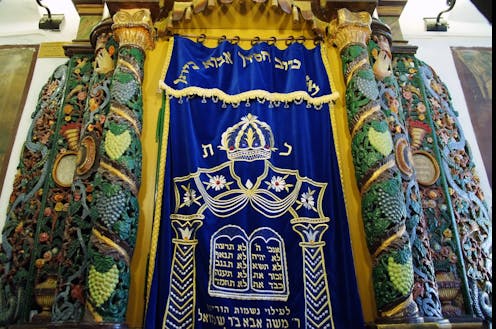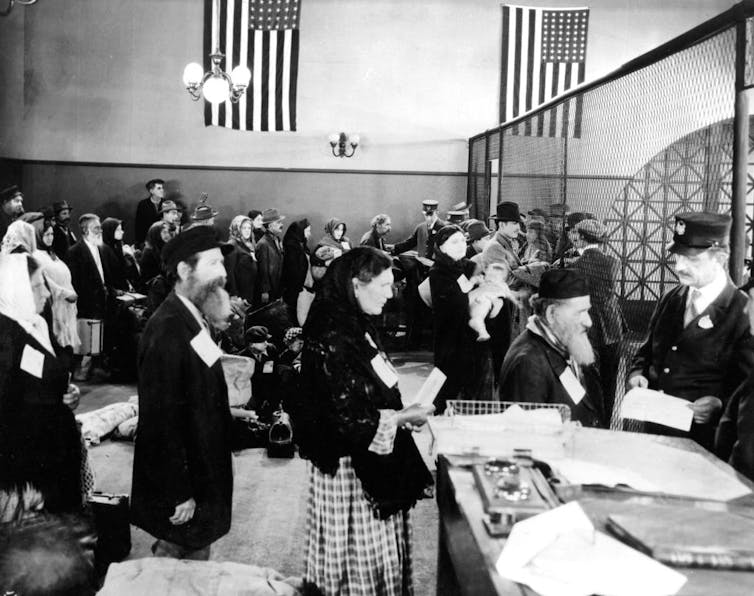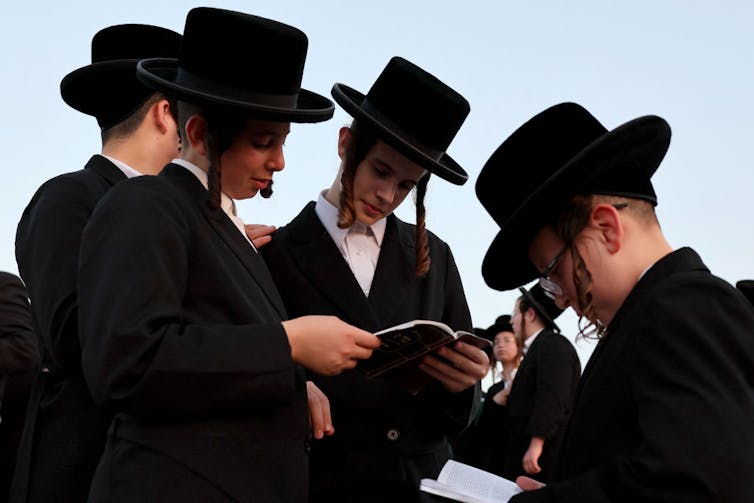Jewish denominations: A brief guide for the perplexed
- Written by Joshua Shanes, Associate Professor of Jewish Studies, College of Charleston
 From Reconstructionism to ultra-Orthodoxy, Judaism is richly diverse.MendyHechtman/iStock via Getty Images
From Reconstructionism to ultra-Orthodoxy, Judaism is richly diverse.MendyHechtman/iStock via Getty ImagesAs a scholar of modern Jewish history, religion and politics, I am often asked to explain the differences between Judaism’s major denominations. Here is a very brief overview:
Rabbinic roots
Two thousand years ago, Jews were divided between competing sects all based on the Jewish scriptures, but with different interpretations. After the Romans destroyed the Jerusalem Temple in 70 C.E., one main group, who called themselves “rabbis” – sages or teachers – began to dominate. What we now know as “Judaism” grew out of this group, technically called “Rabbinic Judaism.”
Rabbinic Judaism believed that God gave Jewish teachings and scriptures to Moses at Mt. Sinai, but that they came in two parts: the “written law” or “written Torah” and the “oral law” or “oral Torah.” The oral Torah is a vast body of interpretations that expands upon the written Torah and is the source for most of the rules and theology of Rabbinic Judaism.
Fearful that these traditions might be lost, the early rabbis began the process of writing them down, culminating in two texts called the Mishna and the Talmud. This corpus became the foundation of rabbinic literature.
The rabbis assured the Jews that although the temple’s destruction was devastating, Jews could continue to serve God through study, prayer and observing God’s commandments, called “mitzvot.” Someday, they promised, God would send the Messiah, a descendant of King David who would rebuild the temple and return the exiled Jews to the land of Israel.
Historic turning point
There were tensions in Rabbinic Judaism from the outset. For example, starting in the Middle Ages, a Jewish group called the Karaites challenged the rabbis’ authority by rejecting the oral Torah.
Even within the rabbinic tradition, there were regular disagreements: between mysticsand rationalists, for example; debates over people claiming to be the messiah; and differences in customs between regions, from medieval Spain to Poland to Yemen.
Still, Rabbinic Judaism remained a more or less united religious community for some 1,500 years – until the 19th century.
Around that time, Jews began to experience emancipation in many parts of Europe, acquiring equal citizenship where they had previously constituted a separate, legal community. Meanwhile, thousands – eventually millions – of Jews moved to the United States, which likewise offered equal citizenship.
 Jewish immigrants arriving at the immigration office on Ellis Island in New York City, around 1910.Apic/Getty Images
Jewish immigrants arriving at the immigration office on Ellis Island in New York City, around 1910.Apic/Getty ImagesThese freedoms brought opportunity, but also new challenges. Traditionally, Judaism was based on Jewish autonomy – communities governed by rabbinic law – and taking the truth of its beliefs for granted. Political emancipation challenged the first, while Enlightenment ideas challenged the second. Jews were now free to choose what to believe and how to practice Judaism, if at all, at a time when they were experiencing widespread exposure to competing ideas.
Three major groups
Competing Jewish denominations emerged, each one attempting to negotiate the relationship between Jewishness and modernity in its own way. Each group claimed that they followed the best or most authentic traditions of Judaism.
The first modern denomination to organize was Reform – first in Germany in the early 19th century, but soon in America as well. Reform Judaism is based on the idea that both the Bible and the laws of the oral Torah are divinely inspired, but humanly constructed, meaning they should be adapted based on contemporary moral ideals. Reform congregations tend to emphasize prophetic themes such as social justice more than Talmudic law, though in recent years many have reclaimed some rituals, such as Hebrew liturgy and stricter observance of Shabbat.
Orthodox Judaism soon organized in reaction to Reform, rallying to defend the strict observance of Jewish customs and law. Orthodox leaders often blurred the distinction between these categories and put particular emphasis on the 16th-century legal code called the Shulchan Aruch. Orthodoxy insists that both the written and oral Torah have divine origins. Contrary views in pre-modern sources are often censored.
 Members of a Reform congregation in Pennsylvania gather for a menorah-lighting ceremony during Hanukkah.Ben Hasty/MediaNews Group/Reading Eagle via Getty Images
Members of a Reform congregation in Pennsylvania gather for a menorah-lighting ceremony during Hanukkah.Ben Hasty/MediaNews Group/Reading Eagle via Getty ImagesConservative Judaism, which did not arrive in the U.S. until the mid-1900s, shares many of Reform Judaism’s views, such as equal religious roles for men and women. However, Conservative Jews argue that the Reform movement pulled too far away from Jewish tradition. They insist that Jewish law remains obligatory, but that the Orthodox interpretation is too rigid. In practice, most Conservative Jews tend not to be strict about even major rituals, like observing Sabbath restrictions or kosher food practices.
There are also smaller but still influential Jewish movements. For example, Reconstructionism, created by Rabbi Mordecai Kaplan in the 1930s and 1940s, emphasizes community over ritual obligations. And the Jewish Renewal movement, born out of the late 1960s counterculture, seeks to incorporate insights from Jewish mysticism with an egalitarian perspective, and without necessarily following the minutiae of Jewish law.
What makes Jewish identities even more complex is that for many Jewish people, being “Jewish” is more of a cultural or ethnic identity than a religious one. Over a quarter of Americans who describe themselves as Jewish say they do not identify with the Jewish religion at all, though Jewish culture or their family’s Jewish background may be very important to them.
It’s also important to keep in mind that Jewish groups evolved in different ways in the Middle East and Northern Africa. Jews from the Muslim world, often called Sephardic or Mizrahi Jews – a minority of American Jews, but over half of Israeli Jews – did not experience the kind of abrupt emancipation that they did in much of Europe. Different Sephardic traditions developed, which are often described as “Masorti” or “traditional” Judaism in Israel, although many of their adherents have become Orthodox in recent years.
From Orthodox to ultra-Orthodox
Of all the Jewish denominations, the Orthodox groups are perhaps most misunderstood. They all share a commitment to Jewish law – especially regarding gender roles and sexuality, food consumption and Sabbath restrictions – but there are many divisions, generally categorized on a spectrum from “modern” to “ultra” Orthodox.
Modern Orthodoxy celebrates secular education and integration into the modern world, yet insists on a relatively strict approach to ritual observance and traditional tenets of belief. They also tend to see Zionism – the modern movement calling for Jewish national rights, today connected to support for Israel – as part of their religious worldview, rather than just a political belief.
The ultra-Orthodox, on the other hand – sometimes called “Haredim” or Haredi Jews – advocate segregation from the outside world. Many continue to speak Yiddish, the traditional language of Jews in Eastern Europe, or to dress as traditional Jews did in Europe before the Holocaust.
This is especially true of Hasidic Jews, who make up about half of the ultra-Orthodox population worldwide. Hasidism is a mystical movement born in 18th-century Ukraine, but today mostly concentrated in New York and Israel. Hasidic Jews are known for being particularly strict about shunning secular culture and education, but they remain also a mystical movement focused on God’s close presence. They are divided into subgroups named after cities in Eastern Europe, and they follow leaders known as “Rebbes,” who wield enormous power in their communities.
Haredim are particularly committed to gender segregation, separating men and women beyond what previous Jewish traditions called for, and tend toward the strictest interpretation of Jewish law, even when traditional understanding of a rule has been more lenient.
 Ultra-Orthodox boys prepare for Yom Kippur, the most important day in the Jewish calendar, in the Israeli city of Netanya.Jack Guez/AFP via Getty Images
Ultra-Orthodox boys prepare for Yom Kippur, the most important day in the Jewish calendar, in the Israeli city of Netanya.Jack Guez/AFP via Getty ImagesWhether modern or Haredi, Orthodox Judaism sees itself as “traditional.” However, it is more accurate to say it is “traditionalist.” By this I mean that Orthodoxy is attempting to recreate a pre-modern religion in a modern era. Not only has Orthodox Judaism innovated many rituals and teachings, but people today have greater awareness that other types of life are available – creating a firm break with the traditional world Orthodoxy claims to perpetuate.
Becoming a nation
Jewish groups are often described as “Zionist.” What is Zionism, and where does it fit in to all these terms?
The first Zionists were mostly secular Jews from Eastern Europe. Inspired by nationalist movements around them, they claimed that Jews constituted a modern nation, rather than just a religion. Traditions and prayers connected to the land – often reinterpreted through a secular, nationalist lens – became all-important for Zionists, while many other rituals and traditions were abandoned.
Most Jews opposed Zionism for decades. Reform Jews and even some early Orthodox Jews worried that defining Jews as a “nation” would undermine their claim to equal citizenship in other countries. Orthodox Jews, meanwhile, opposed Zionists’ staunch secularism and emphasized that Jews must wait for the Messiah to lead them back to the land of Israel.
Within a decade or two of Israel’s establishment as a modern state, however, most Jewish denominations integrated Zionism into their worldview. Still, most ultra-Orthodox Jews today continue to oppose Zionist ideology, even as they hold right-wing political views on Israel. Young liberal Jews, too, are increasingly emphasizing the distinction between Zionism and their own Jewish identity.
Today, most U.S. Jews are either unaffiliated with any particular denomination or Reform. However, the percentage of Jews who are Orthodox – especially ultra-Orthodox, whose members tend to have very large families – is growing rapidly. Almost 10% of American Jews and nearly 25% of Israeli Jews are Orthodox today, although attrition from these communities is also rising.
This trend may continue, or that sector may see mass defections, as it did a century ago. Either way, Orthodoxy is going to continue to play a very important role in Jewish life for many years to come.
This article has been updated to correct a chart caption and include information about Masorti Judaism.
Joshua Shanes does not work for, consult, own shares in or receive funding from any company or organization that would benefit from this article, and has disclosed no relevant affiliations beyond their academic appointment.
Authors: Joshua Shanes, Associate Professor of Jewish Studies, College of Charleston
Read more https://theconversation.com/jewish-denominations-a-brief-guide-for-the-perplexed-207297

